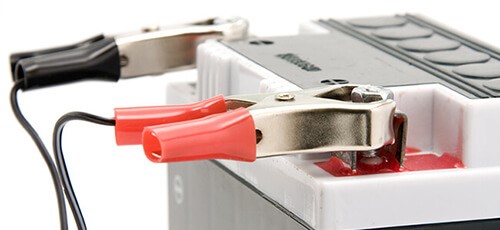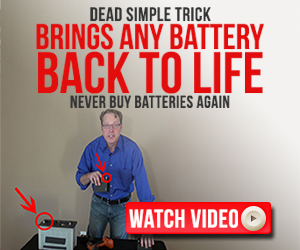There are two common types of battery chargers that are used to charge, and even maintain, lead-acid batteries like car, boat, motorcycle, truck, golf cart, ATV, and RV batteries – Smart/Automatic chargers & Manual chargers.
In short, the main differences between Smart/Automatic chargers & Manual chargers is (#1) the way they charge the battery and (#2) how you should use the charger. So, let’s take a look at the differences. We’ll discuss Smart/Automatic chargers first…
SMART/AUTOMATIC CHARGERS
Smart/Automatic chargers are intelligent multi stage chargers. These chargers monitor the battery constantly and only charge the battery when needed. So, it does not overcharge or undercharge the battery no matter how long the charger is connected to the battery (*this is critical difference between a Smart/Automatic charger and a Manual Charger as you’ll see).
What’s nice about Smart Chargers is that you can leave them connected to the battery as long as you want (or are away) because they are designed to fully charge and maintain lead-acid batteries (like car, marine, motorcycle, and truck batteries) automatically.
A lot of people don’t realize that modern cars continue to drain your car battery even when the vehicle is turned off because things like the security system, sensors, etc. continue to use power. So, if you don’t plan on starting your vehicle for a while (or if you don’t plan on using another type of lead-acid battery for a while) and you don’t want to come back to a dead battery, we recommend connecting a Smart Charger to the battery before you leave because the Smart Charger will continue to monitor your battery and charge it when necessary (and it will not overcharge the battery).
Smart chargers will also help prevent sulfation in the battery because if a battery is left partially charged for a prolonged period, sulfation occurs which prevents the battery from taking on a full charge. But if your battery is always fully charged, this does not happen.
But Smart Chargers aren’t perfect for every situation. Two problems with Smart/Automatic chargers are:
(1) If your battery is totally dead and registering zero volts, these types of chargers will often not work and will not charge the battery.
(2) These types of chargers do not allow you to perform an equalizing charge to recondition the battery and remove sulfation.
However, Smart Chargers are great if you plan on leaving your battery unused for a while and don’t want to come back to a dead battery or if you want a “set it and forget it charging solution” that works well for partially charged batteries.
Here is an example of quality smart charger we recommend.
MANUAL CHARGERS
Manual chargers are typically less expensive than Smart Chargers. Manual Chargers do not analyze the battery so these chargers will continue charging your battery until the charger is disconnected from the battery (or unplugged).
When using a Manual Charger, it’s important to monitor the battery carefully so you don’t overcharge the battery and cause a dangerous condition or damage to the battery.
One thing we like about Manual Battery Chargers is that you can apply an equalizing charge to the battery to help recondition it. An equalizing charge is essentially a controlled overcharging of the battery to help break up the sulfation in the battery.
You have to use a Manual Charger to perform an equalizing charge because a Smart charger will prevent you from applying an equalizing charge because it will shut off if the battery is fully charged – but Manual battery chargers will not shut off and will allow for a controlled overcharging of the battery. Some Smart chargers may have settings that attempt to apply an equalizing charge but manually applying an equalizing charge with a Manual Battery Charger does a better job typically.
Another benefit of a Manual Charger is that they will charge your battery even if your battery is totally dead. As we previously noted, Smart Chargers typically won’t charge a battery with zero volts. But a manual charger will. So, if you want to charge a dead battery, you can either:
(1) Use the Manual Charger to fully charge the battery (*while monitoring the battery to make sure you don’t overcharge it).
(2) Or you could use the manual charger to get it’s voltage up to something the Smart Charger can detect, then disconnect the Manual Charger, and connect the Smart Charger to the battery to finish charging it (*in this scenario, you can leave the battery and not monitor it anymore after the Smart Charger is connected because a Smart Charger will not overcharge the battery).
Here is an example of a quality Manual Battery Charger.
WHAT SHOULD YOU USE? AND WHAT DO WE USE?…
The biggest differences between Smart/Automatic battery chargers and Manual battery chargers is whether they monitor the battery while charging it. If you’re using a Smart Charger/Automatic charger then the battery will be monitored and there is no fear that the battery will be damaged because it was overcharged, so the charger can be left connected as long as you want. However, if you use a Manual charger, it will not monitor the battery while charging it, so you will have to disconnect the charger after the battery is fully charged.
Additionally, a manual charger will allow you to charge a totally dead battery if it has zero volts (unlike a smart charger) and it will also allow you to apply an equalizing charger to break up a battery’s sulfation (unlike a smart charger).
We personally have both a Smart/Automatic charger and also a Manual charger for different purposes. We like using our Smart/Automatic charger to keep our batteries maintained if we’re not using them and/or if we want to charge a partially charged battery without monitoring it as it charges. But we also need to use our Manual charger to charge old, dead batteries we pick up around town (because our Smart Charger won’t charge these if they have zero volts) and also to apply equalizing charges.
Hopefully this article helps you decide whether a Smart/ Automatic charger or Manual battery charger is the correct charger for you.



1 Response to "Differences Between Smart/Automatic Battery Chargers & Manual Battery Chargers"
Thank you. I was looking for a new charger for my 12v car battery. This helped a lot